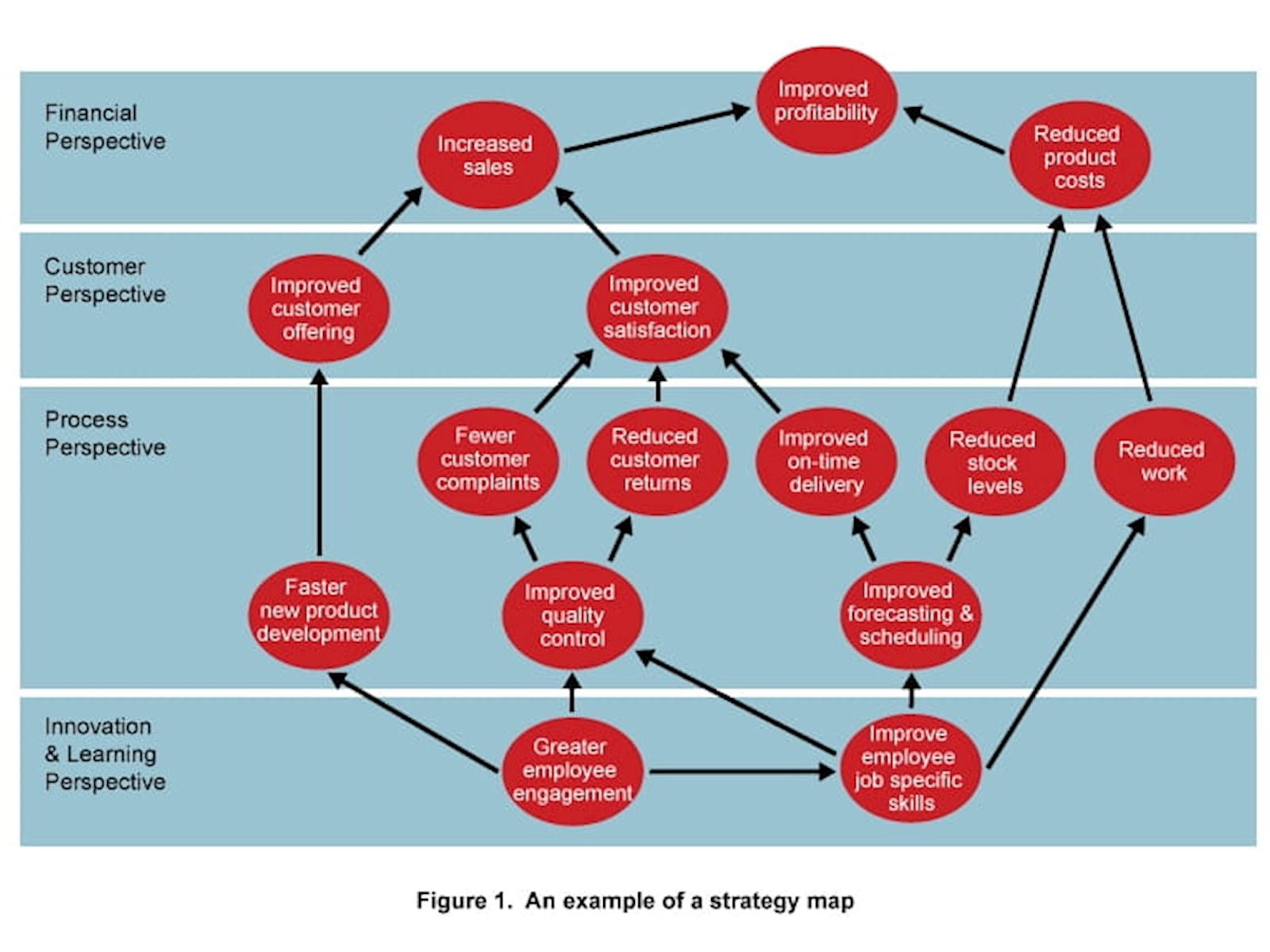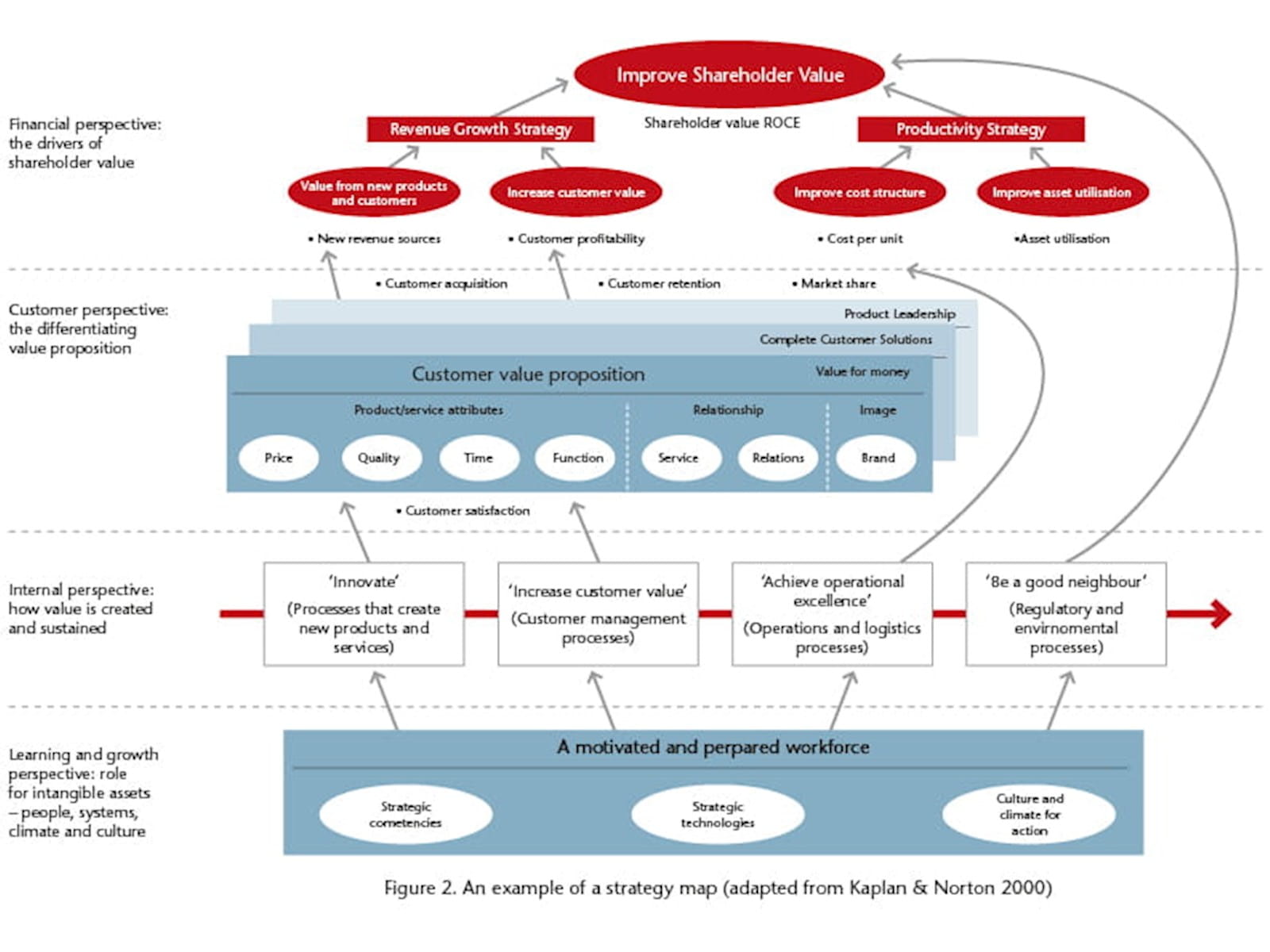Analyse the strategic drivers of financial performance.
Introduction
Strategy Maps are a strategic plan presented visually on one page. Typically they contain the key elements required to deliver the strategy. Traditional Strategy Maps have the four layers of the Balanced Scorecard, so from top to bottom include:
- Financial objectives
- Customer objectives
- Process objectives
- Innovation and learning objective (or people objectives)
The objectives are linked to each other. So the achievement of the higher level objectives will be delivered through achievement of the lower level objectives. In this way a Strategy Map will show you both how the strategy is to be achieved and why the objectives are important to the business.
Examples
Figure 1 shows an early example of a Strategy Map that links the individual objectives tightly together showing the cause and effect relationship between what is to be achieved and how it is to be achieved (reading the Strategy Map from the top down) and between what is being done and why it is being done (reading the Strategy Map from the bottom upwards).

Figure 2 shows a later version of a Strategy Map where the linkages between objectives are more general. In this version, the Strategy Map can be used as a template as the approach uses three generic strategies:
- Being operationally excellent – providing the best value products at least inconvenience to the customer
- Being Customer intimate – knowing your customers’ requirements better than they do and providing service that no one else can match
- Being a product leader – having the best product available
Strategy Maps are really about alignment. You need to align your processes and innovation and learning activities with the way you compete in the market. Two academics (Treacy & Wiersema) have long argued that there are only three generic ways to compete, (operational excellence, customer intimate or product leader) and that you can’t do all three at the same time. So you have to make a choice and then align the business to competing in that way. Figure 2 is a generic example of this approach.

Advantages
- To communicate strategy it is very useful to be able to show the strategy on a single page.
- It tells everyone in the organisation what is to be achieved.
- It explains to everyone in the organisation how what they do fits in to delivering strategy.
Pitfalls to be avoided
- In most organisations only a few people do “Strategy”, so “Strategy” is seen as somebody else’s job. Ideally you want to engage widely in the implementation of strategy, so just be aware that using the term Strategy Map can put off some of your employees. For this reason I prefer the term Success Map.
- Don’t let your Strategy Map lie idle or just appear on the notice board. I have seen too many companies were when you ask about the Strategy Map on the wall, you get the reply that someone else has done it (usually a consultant) and they don’t really know what it is about. Strategy Maps live when they are at the heart of conversations and debates throughout the business.
- You can’t put everything on a Strategy Map, it will become too complicated, so keep it to a broad brush view of strategy.
- In my opinion, how you create your Strategy Map is as, if not more, important than the map itself. To find out how do this look at the Success Mapping section.
Bibliography
- Kaplan, R. S. & Norton, D. P., (1996b), The balanced scorecard - translating strategy into action, Harvard Business School Press, Boston, MA, USA.
- Kaplan, R. S. & Norton, D. P., (2000), " Having Trouble with Your Strategy? Then Map It", Harvard Business Review, Sept/Oct., 167-176.
- Kaplan, R. S. & Norton, D. P., (2008), The execution premium: linking strategy to operations for competitive advantage, Harvard Business School Press, Boston, MA, USA.
Related research
Since this article was written in 2015, further research has been carried out into strategy maps.
These articles and others are available below to logged-in ICAEW members and ACA students.
Online articles
The Library provides access to leading business, finance and management journals. These journals are available to logged-in ICAEW members, ACA students and other entitled users subject to suppliers' terms of use.
More support on business
Read our articles, eBooks, reports and guides on strategy, risk and innovation.
Strategy, risk and innovation hubeBooks on business strategy and planningCan't find what you're looking for?
The ICAEW Library can give you the right information from trustworthy, professional sources that aren't freely available online. Contact us for expert help with your enquiries and research.
-
Update History
- 16 Dec 2015 (12: 00 AM GMT)
- First published
- 29 Mar 2022 (12: 00 AM BST)
- Page updated with Related research section, adding further reading on strategy maps. These new articles provide fresh insights, case studies and perspectives on this topic. Please note that the original article from 2015 has not undergone any review or updates.

